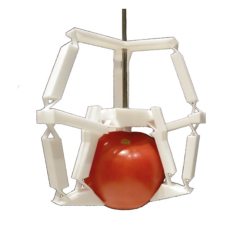In life, we face challenges in food production and harvesting. With the growing population, the demand for food is increasing. However, current farming practices, including monoculture farming with a heavy reliance on pesticides and insecticides, threaten biodiversity. To tackle this issue, mixed cropping is a viable solution, but it presents new challenges such as harvesting crops at different times, machine compatibility, and high labour costs. This is why, as part of the FlexCRAFT project, the University of Twente is working on a new flexible robotic technology that is multifunctional and addresses these challenges.
Development of gripper technology
 FlexCRAFT is a Dutch research programme that aims to develop new robotics solutions for agriculture and food processing. In this project, the University of Twente is collaborating with four different universities and fourteen companies, supported by the Dutch Research Council (NWO). At the University of Twente, research focuses primarily on the development of gripper technology, a key component of the robotic system. Jan de Jong, assistant professor at the University of Twente and primary investigator of the FlexCRAFT project: “Although grippers seem to be only a small part of the robot, they are often the most mechanically complex and least understood part.”
FlexCRAFT is a Dutch research programme that aims to develop new robotics solutions for agriculture and food processing. In this project, the University of Twente is collaborating with four different universities and fourteen companies, supported by the Dutch Research Council (NWO). At the University of Twente, research focuses primarily on the development of gripper technology, a key component of the robotic system. Jan de Jong, assistant professor at the University of Twente and primary investigator of the FlexCRAFT project: “Although grippers seem to be only a small part of the robot, they are often the most mechanically complex and least understood part.”
Robots need the human sense of touch
The cultivation of mixed crops demands a high degree of tactile feedback, which is a significant obstacle for robotic systems. Dannis Brouwer, a full professor at the University of Twente and an expert in robotic engineering, explains that robots require tactile feedback, similar to the human sense of touch. “For instance, when a person holds a tomato, they can sense the quality of their grip and make adjustments if necessary to prevent bruising the tomato or increasing pressure if the tomato starts to slip away.” Jan de Jong adds: “Although robots equipped with grippers are available, creating human-like and robust tactile feedback remains a major technological challenge in the field of robotics.”
Efficient gripper movements with flexures
Elastic mechanisms, also known as flexures, move through elastic deformations of thin strips of material and precisely return to their original form when the force is removed. "This can be compared with a ruler, because when you bend it and release the force, it will be straight again," Jan explains. "We apply this principle in the development of grippers, where a small strip of material is attached at the place of a hinge and can make a small rotation. So if we know the deformation, we exactly know the gripping force. Because the flexures allow motion without play and friction, they are very predictable, which enables the prediction of the grip with only a limited number of sensors. Additionally, flexures are open structures that do not need lubricants and can therefore be cleaned quickly, which is a valuable trait when interacting with food products such as meat.
To avoid the need to equip the joints with sensors, which are expensive and not very robust, a few sensors in the wrist or arm can measure the tension of certain cables. This is similar to how tendons and muscles work in the human body. Using the flexure approach, instead of using bearings, enables an efficient prediction of movement with a limited number of sensors.





